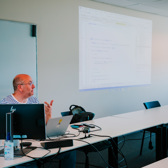Analyzing your data with Power BI for Business Users
UPBIBDP
3 days
Interested in a private company training? Request it here.
Introduction to Power BI
This module introduces the fundamental concepts of the Power BI platform. It provides a high-level overview of the Power BI Desktop application and the Power BI Cloud Service.
- The need for Business Intelligence
- Self-Service BI versus Enterprise BI
- Core concepts of Power BI
- Introducing Power BI Desktop
- Introducing the Power BI Service
- Power BI Service Tiers and Features
Loading Data with Power BI Desktop
In this chapter you will learn how to create queries in Power BI Desktop to extract data from source systems like SQL Server, Oracle, Excel files, CSV files, and so on. Applying transformations that can filter, sort and clean the extracted data will also be covered.
- Core Concepts of Power Query
- Creating Queries to load data
- Applying Basic Transformations
- Working with Direct Query
- LAB - Creating queries with Power BI Desktop
Enhancing a Data Model in Power BI Desktop
You will gain insights into enhancing a data model by constructing hierarchies within tables and assigning columns meaningful names and appropriate data types. You will discover how to employ measures and calculated columns, thus advancing your model. Additionally, the significance of establishing accurate relationships between tables will also be covered.
- Renaming & Hiding Columns and Tables
- Column Data Types and Formatting
- Working with Numerical Columns
- Sorting Columns
- Data Categorization
- Creating Hierarchies inside tables
- Defining Calculated Columns and Measures using DAX
- Working with Quick Measures
- Defining Relationships between Tables
- LAB - Enhancing a Data Model in Power BI Desktop
Designing Reports in Power BI Desktop
After the data model has been fine-tuned, we can use it to create our reports. Power BI allows you to create very impressive reports, and in this module we will explore many visualizations as well as the interaction between these visualizations.
- Overview of the Report Canvas
- Adding Text Boxes, Shapes and Images
- Using built-in Visualizations
- Custom Theming
- Printing a Power BI Report
- Power BI Templates
- LAB - Designing Reports in Power BI Desktop
Enhancing Reports in Power BI Desktop
Sometimes a static report just isn't enough. In this module you'll learn how to make interactive reports which are easy to use for any type of end user. Take your reports to the next level!
- Slicers and Filters
- Drill through Pages
- Custom Tooltips
- Bookmarks
- Visual Hierarchies and Drill-down Behaviour
- Grouping and Binning
- Dynamic Behaviour with Parameters
- Custom Visuals
- Report Mobile Design
- LAB - Enhancing Reports in Power BI Desktop
Introduction to the Power BI Service
If you want to share models and reports with you co-workers, you should upload them to the Power BI Service. In this module you will learn about the general features of the Power BI Service, the next modules dive into the details.
- Power BI Service Overview
- Power BI Service Tiers and Features
- Working with Datasets and Reports
- Creating and using Workspaces
- LAB - Introduction to the Power BI Service
Creating Datasets and Reports in Power BI Service
For some types of reports you do not want to go through the hassle of creating a dataset in Power BI Desktop. That's why for a limited set of data sources we can start using them directly from the Power BI service without the need to first create an offline model. In this module you'll learn how to create these models directly in the Power BI Service.
- Creating Datasets in the Power BI Service
- Connecting to Datasets in Power BI Desktop
- Dataset Configuration and Permissions
- Creating Reports in the Power BI Service
- Configuring and Exporting Reports
- LAB - Creating Datasets and Reports in Power BI Service
Creating Dashboards and Analyzing Data with Power BI Service
Dashboards enable you to integrate visuals from various reports onto a single page for swift access. This module instructs you on constructing and customizing these dashboards within the Power BI Service. You will also learn how to connect datasets in Excel Pivot Tables and keep track of important KPIs using Scorecards.
- Creating & Configuring Dashboards
- Working with Power BI Q&A
- Analyze Datasets in Excel
- Metrics and Scorecards for KPI tracking
- LAB - Creating Dashboards
Sharing Content in the Power BI Service
Power BI has different mechanisms to share content with other users: Sometimes you want to share in order to develop something together, or you want others to customize something, or maybe you want others to have read-only permissions on the shared object. In this module you'll learn how to accomplish this with the different sharing options in the Power BI Service.
- Sharing Reports and Dashboards with internal and external users
- Sharing content inside a Workspace
- Creating & Consuming Power BI Apps
- Publishing Reports to the web
- Subscribing to Report updates
- Embedding a report in SharePoint Online or Microsoft Teams
- Report Usage Metrics
- LAB - Sharing Content in the Power BI Service
Using Power BI with Mobile Devices
In this module, you will learn how to install and utilize the mobile Power BI application on your phone. You will discover the capabilities and limitations compared to the browser-based Service.
- Supported Platforms
- Accessing Reports, Dashboards and Datasets from mobile devices
Power BI is a suite of business analytics tools to analyze data and share insights. Power BI Desktop transforms your company's data into rich visuals for you to monitor your business and get answers quickly with reports and dashboards available on every device.
This course covers the whole idea of Power BI. You learn how to connect to any data source using Power Query. The next step is enhancing the Data Model by using relationships, hierarchies, calculated columns, and measures. When the model is finished, you will build an interactive report and maintain & share it in the Power BI Cloud Service.
This course is intended for business users without any prior knowledge of Power BI. No technical or IT background is required.







